Winemaking has undergone transformational changes since its inception, evolving through various eras of technological and methodological advancements. The catalyst for this evolution was none other than the Industrial Revolution, which played a pivotal role in shaping the wine industry into what it is today.
As you explore the history, you’ll see that this period brought forth significant innovations, from mechanization of the grape harvest to the industrial production of wine bottles, dramatically affecting production efficiency and wine quality.
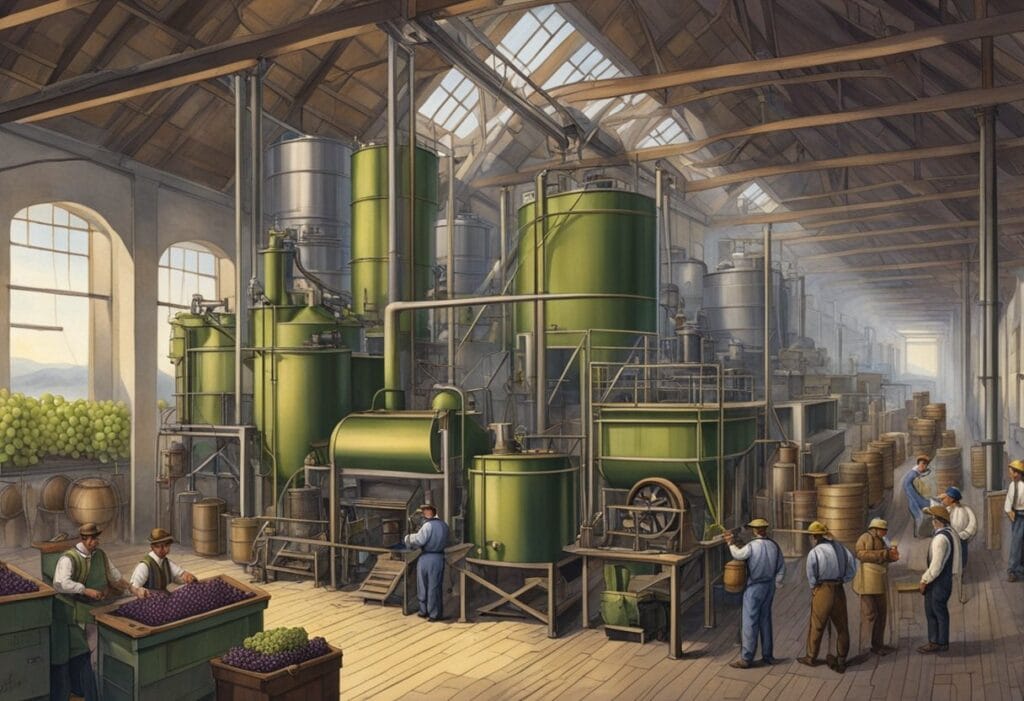
With the advent of the 4th Industrial Revolution, artificial intelligence and other innovative technologies have been integrated into the winemaking process. These advancements are refining operations in vineyards and wineries, enhancing wine quality, and reshaping viticulture.
As a result, the role of AI in winemaking has become increasingly prominent, allowing for precision agriculture practices and data-driven decision-making. Your understanding of modern winemaking will now include smart, connected processes that contribute to sustainability and cater to consumer preferences in an ever-changing climate.
Key Takeaways
- The Industrial Revolution introduced significant innovations that reshaped winemaking.
- Advancements in AI and technology enhance wine quality and viticulture practices.
- Modern winemaking integrates precision agriculture, contributing to sustainability.
Historical Background of Winemaking
Winemaking is an ancient craft that dates back to the Neolithic period. Initially, evidence of Neolithic wine-making suggests that as early as 7000 BC, people had started to ferment grapes, creating a primitive form of wine. This period saw the start of structured winemaking, where people began domesticating wild grapes and improving fermentation techniques.
Your journey into the historical world of winemaking would reveal that by 4000 BC, wineries were in operation in the region that is now called Armenia. You might notice that these early wineries employed techniques that laid the foundation for modern winemaking practices.
Moving forward, by 3000 BC, Sumerians had integrated wine into their culture, effectively making it a staple for both religious ceremonies and daily life. The Sumerian influence on winemaking was profound, with their innovations spreading across the region.
Ancient Greeks took winemaking to a new level during what is often referred to as the Golden Age. Here, wine became synonymous with daily life, philosophy, and the arts. Innovations such as the use of amphorae for the wine trade enabled wine to become a major trading commodity throughout the Mediterranean.
By integrating viticulture with their cultural practices, the Greeks significantly enhanced winemaking processes and quality, setting a high standard that would carry forward into Roman times and beyond. Each step toward modern winery from those times has been built on the rich historical foundation laid by our ancestors, as you can track the lineage of every bottle back to these early civilizations and their dedication to the craft of winemaking.
Evolution of Industrial Revolution in Winemaking
The Industrial Revolution brought significant changes to the winemaking process, from manual labor to sophisticated technology, enhancing both production and quality.
From Manual to Mechanical
Initially, winemaking was labor-intensive, with every step, from harvesting grapes to pressing them, done by hand. The Industrial Revolution introduced mechanical presses, which significantly increased efficiency in wine production. These devices allowed for greater juice extraction with less human effort.
Technological Advancements in Viticulture
Viticulture saw transformative advancements thanks to technology, such as temperature-controlled fermentation tanks. This technology assured more consistent wine quality and allowed winemakers to experiment with new styles. Moreover, automation in irrigation and harvesting allowed for precise control over grape cultivation.
Impact on Wine Quality and Production
The technology of the Industrial Revolution not only boosted wine production levels but also greatly improved wine quality. With the advent of germ theory, innovations such as pasteurization eliminated much of the unpredictability in winemaking, leading to more reliable and safer wines. Modern filtration systems further ensured the clarity and stability of wine, appealing to evolving consumer standards.
The Role of AI in Modern Winemaking
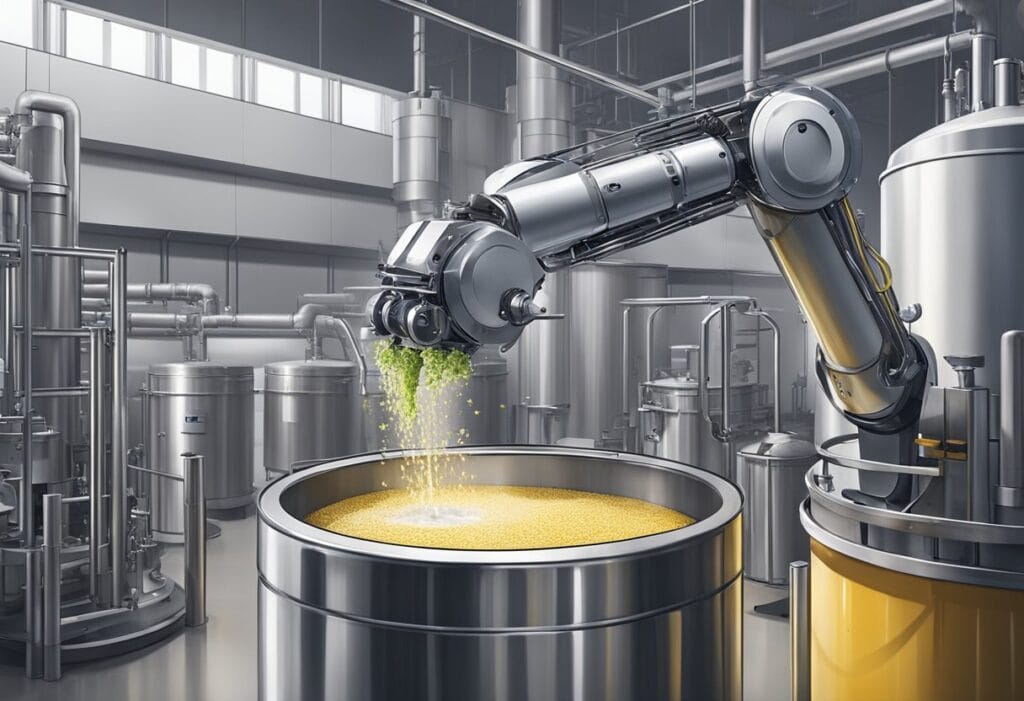
Artificial intelligence is revolutionizing your winemaking experience, from the vineyards to the bottle. AI-powered machines and data analysis are integral components, ensuring precision and efficiency throughout the winemaking process.
Artificial Intelligence in Agriculture
Your vineyard management is drastically improved with the use of artificial intelligence (AI). By employing AI technologies, such as deep neural networks and GAIA (a comprehensive agriculture-focused AI system), you can now analyze vast datasets from IoT sensors. These systems monitor soil moisture, crop health, and weather conditions, allowing for timely and informed decision-making to maximize grape quality.
Automation of Winemaking Processes
Automation has streamlined the numerous, labor-intensive steps involved in transforming grapes into wine. AI excels in repetitive and precise tasks, ensuring consistency in bottling, corking, and labeling. This level of automation not only increases productivity but also minimizes human error, leading to a more reliable quality of wine.
Predictive Analytics for Wine Quality
In the wine industry, predicting the quality of wine is paramount. AI’s ability to perform intricate data analysis provides forecasts on the potential quality of wine, giving you insights into fermentation processes and flavor development. This predictive power is built on historical data and current environmental factors influencing grape characteristics, guiding you towards crafting wines that meet desired quality standards.
By integrating AI into your winemaking journey, you adopt a blend of tradition and innovation, ensuring that your wine not only preserves its heritage but also meets modern standards of perfection.
Viticulture and Climate
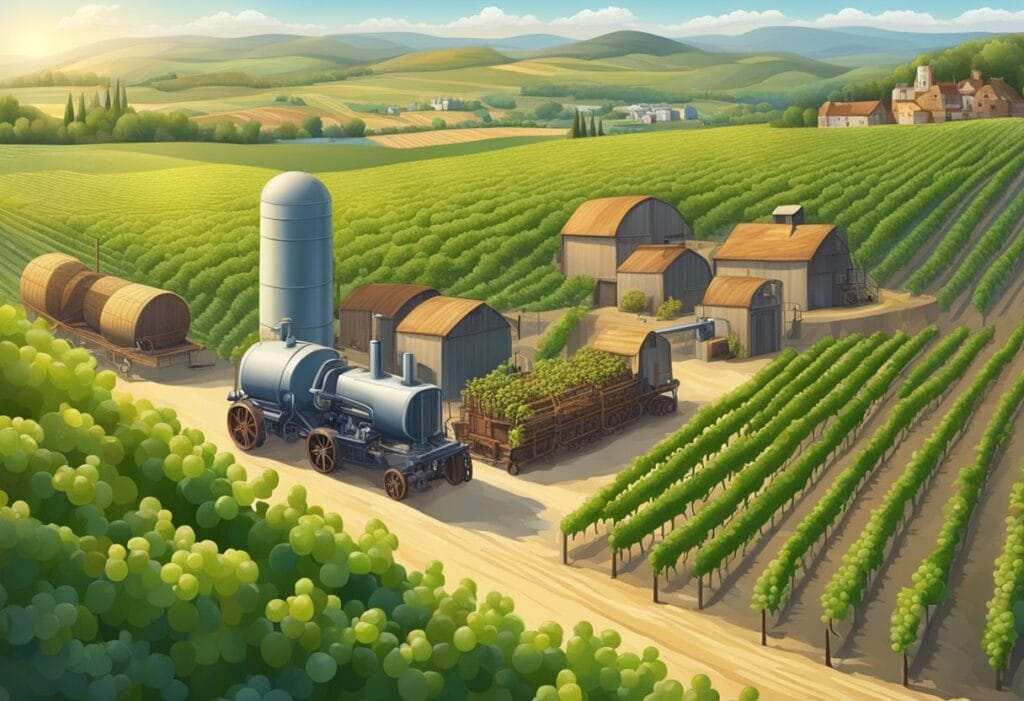
As you explore the world of winemaking, understanding the intricate relationship between viticulture and climate is crucial. Your wine’s quality starts with healthy grapevines, which rely on precise soil and water management and are increasingly affected by changing climate conditions.
Soil Conditions and Management
To produce high-quality grapes, soil conditions must be carefully managed. Your choice of soil impacts not only the nutrients available to the grapevines but also how water is retained and drains. Heavy soils like clay retain water well but can lead to waterlogged vines.
In contrast, sandy soils drain quickly and may require more frequent irrigation. Implementing sustainable soil management practices like cover cropping can enhance soil structure, improve its water-holding capacity, and promote the overall health of your vineyard.
Water Needs and Irrigation Technology
Water is a vital component in grape cultivation, affecting everything from the plant’s growth cycle to the final taste of the wine. Your grapevines need a balanced amount of water; too little and they stress, too much and they lack flavor concentration.
Advances in irrigation technology, such as drip irrigation systems, allow you to control water application precisely, ensuring the vines receive the optimal amount of water at the right time, which is essential in areas where water resources are scarce or climate conditions are variable.
Climate Impact on Grape Cultivation
Climate conditions have a profound impact on viticulture, influencing which grape varieties you can grow and the types of wine you can produce. Warmer climates tend to hasten grape ripening, leading to higher sugar content and lower acidity, whereas cooler climates contribute to slower ripening, resulting in wines with higher acidity and more subtle flavors.
You must monitor and adapt to these conditions, as shifts in climate patterns can alter historical growing seasons and potentially introduce new pests and diseases to your vineyard. The ongoing climate change poses challenges but also creates new opportunities for innovation in winemaking.
Innovative Tools and Technologies
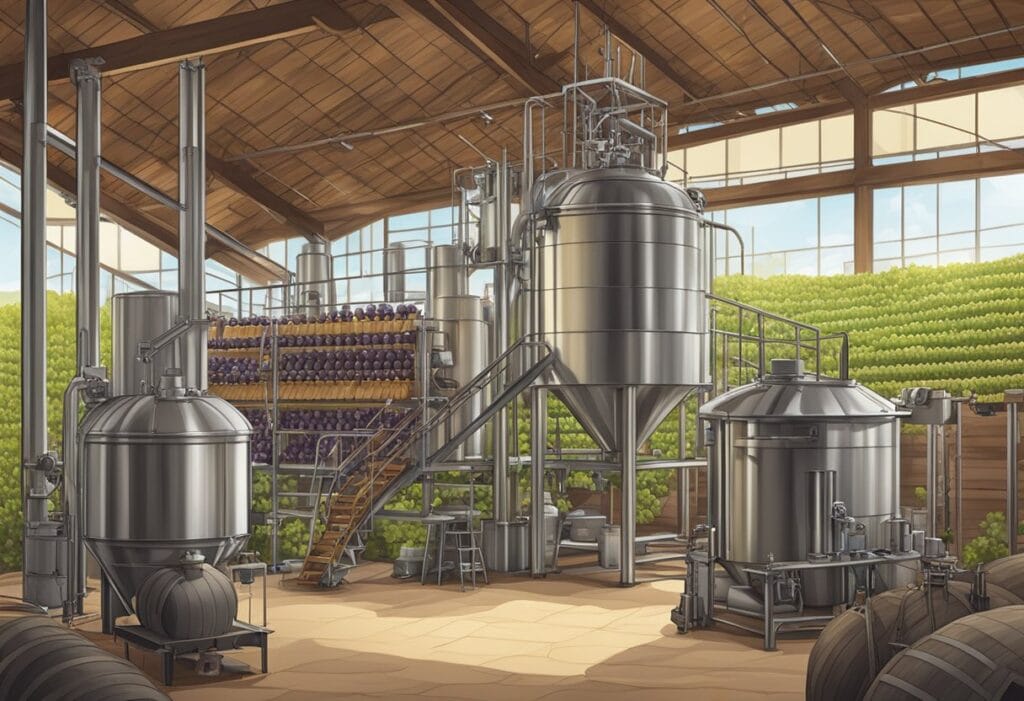
The introduction of sophisticated tools and cutting-edge technologies in winemaking has revolutionized the industry. You now have access to advanced systems that enhance precision and efficiency from vineyard to bottle.
Sensors and Monitoring Systems
Your ability to maintain optimal vineyard conditions is greatly improved by using sensors and monitoring systems. These tools collect data on soil moisture, vine health, and microclimates to inform your decisions. Real-time analytics enable vineyard managers to optimize irrigation, harvesting times, and pest control measures.
- Soil Moisture Sensors: Track water levels to manage irrigation precisely.
- Climate Sensors: Monitor temperature and humidity to protect vines from adverse weather conditions.
Automated Drones and Vehicles
Automated drones and autonomous vehicles are increasingly becoming integral to modern viticulture. Drones provide aerial imagery that helps you monitor crop health and growth progress, while autonomous vehicles can handle repetitive tasks like pruning, harvesting, and spraying, reducing labor needs and costs.
- Drones: Offer aerial photography and data collection for crop analysis.
- Autonomous Tractors: Carry out vineyard tasks with minimal human supervision.
Thermal Imaging and Disease Detection
Thermal infrared cameras attached to drones or vehicles are a game changer in early disease detection. These cameras capture heat signatures that can indicate plant stress or infection before visible symptoms appear, giving you a crucial head start on treatment interventions.
- Thermal Cameras: Identify subtle temperature variations to spot potential issues early.
By embracing these technologies, you’re empowered to improve vineyard health, optimize production, and ultimately enhance wine quality.
Industrial Revolution’s Influence on Wine Quality
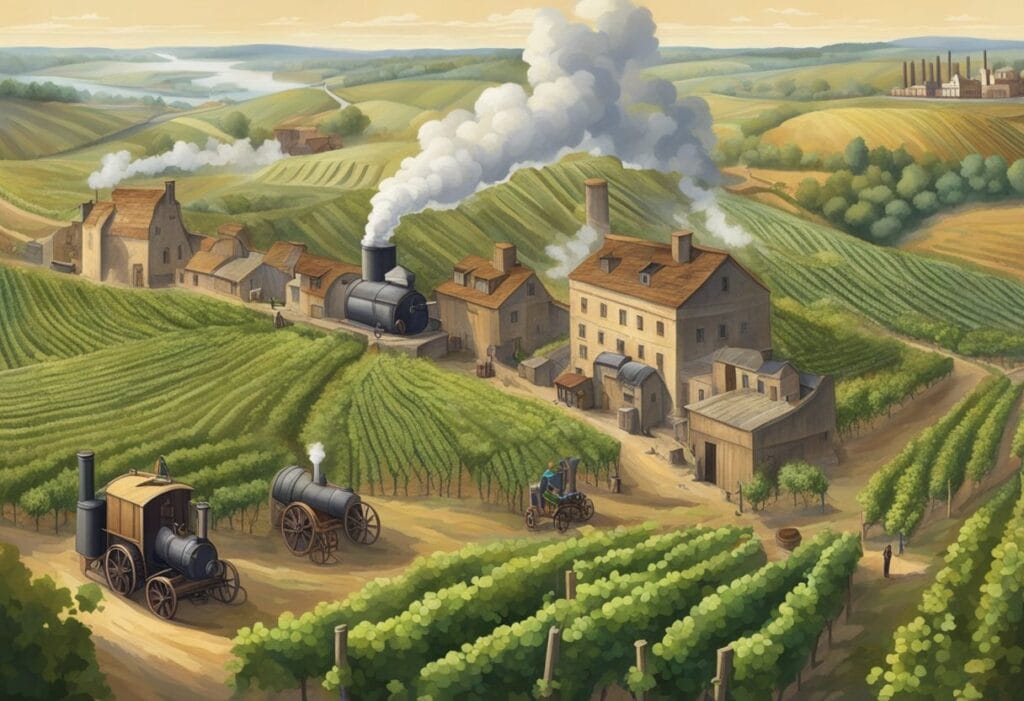
As you explore the intersection of technology and winemaking, you’ll find that the Industrial Revolution has significantly enhanced the quality of the wine you enjoy today through precision in quality control, advancement in flavor and aroma development, and standardization of production methodologies.
Wine Quality Control Methods
Automated Monitoring Systems: Gone are the days of guesswork in vineyards. The advent of automated sensors allows you to monitor crucial factors like soil moisture and weather conditions, leading to consistent grape quality year after year. These systems optimize irrigation and reduce the chances of grape diseases, which directly contributes to the superior quality of the vintage you savor.
Contributions to Aroma and Flavor
Precise Fermentation Techniques: Your experience of a wine’s aroma and flavor is now more refined, thanks to controlled fermentation practices. The implementation of stainless-steel tanks with temperature regulation has revolutionized the winemaking process. This precise control over fermentation temperatures ensures that each grape varietal expresses its unique character, enhancing your wine’s bouquet and taste.
Standardization of Production
- Uniform Quality: The standardization initiatives during the Industrial Revolution have resulted in a consistent caliber across various wine batches. You now get to enjoy quality wine at various price points.
- Process Efficiency: Streamlined production lines and mechanized bottling have reduced human error and enhanced the efficiency of wine production. This assures you that the bottle of wine on your table not only tastes good but also meets high standards of quality control.
By integrating technology into traditional practices, the wine industry has evolved to produce wines that consistently meet your expectations for quality, aroma, and flavor. The innovations from the Industrial Revolution in winemaking have ensured that with each bottle you uncork, you’re experiencing the best that vineyards can offer.
Consumer Interactions and Marketing
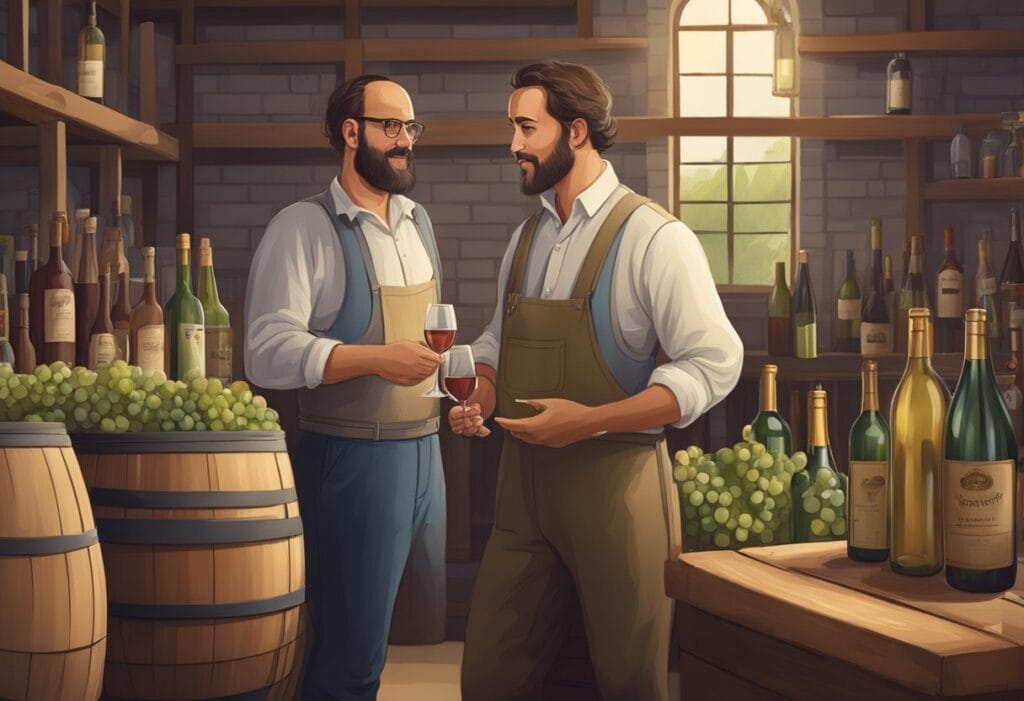
In the dynamic world of winemaking, your connection with consumers and innovative marketing strategies are pivotal. Below, key areas such as tourism, personalized experiences, and the impact on purchasing behaviors showcase the evolution of consumer engagement in the wine industry.
Tourism and Marketing Strategies
You’ll find that wine tourism has become an integral part of the industry, offering you more than just a tasting, but an immersive experience. Many wineries partner with tourism companies to create compelling tour packages that often include vineyard tours, wine tastings, and educational sessions about winemaking. As part of marketing strategies, wineries also produce marketing videos that give a virtual taste of what to expect, helping to attract visitors from across the globe.
Personalization of Consumer Experience
The personalization of consumer experience stands as a cornerstone for sustainable growth. By utilizing data and AI technologies, wineries can now offer you a tailored experience, suggesting wines that align with your taste profiles and past purchasing habits. This sophisticated approach not only caters to individual preferences but also encourages repeat business and loyalty from you, the consumer.
Impact on Wine Buying and Consumption
The buying and consumption patterns of wine drinkers like you are significantly influenced by how the wine industry markets its products. The presence of wines in retail spaces is enhanced by in-store displays and staff recommendations. Additionally, the rise of online marketplaces has reshaped how you interact with and purchase wine, with a shift towards more direct-to-consumer sales channels, allowing a more personalized and convenient buying experience.
Wine Industry and Modern Retail
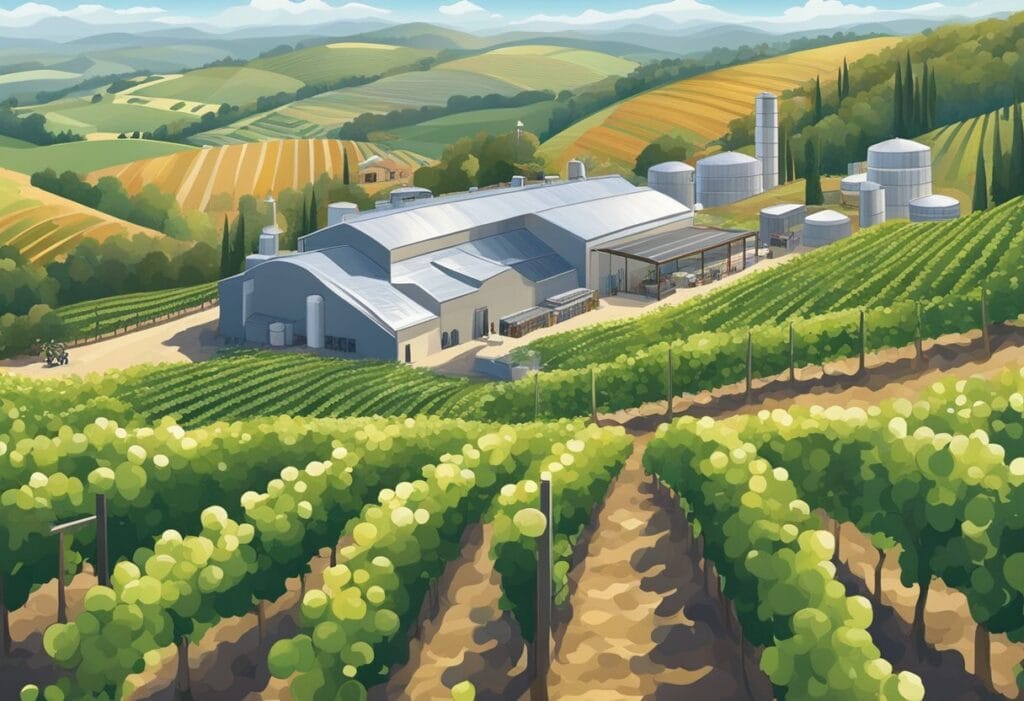
In recent years, the wine industry has seen a significant shift towards online and modern retail environments. By understanding these changes, you can navigate the new landscape of wine shopping.
E-commerce and Online Retail
The advent of e-commerce has revolutionized how you purchase wine. With the click of a button, you can now explore a vast selection of wines from all over the world and have them delivered directly to your doorstep.
This convenience is a game-changer, especially for those who value a wide selection and the ability to shop at any time. Online wine sales platforms have also introduced innovative features like personalized recommendations, wine subscriptions, and virtual tastings, further enhancing your wine-buying experience.
Influence on Local Retailers
Local retailers are adapting to the rise of digital commerce in the wine industry. They’re leveraging their unique position by offering you personalized service and curated experiences that can’t be replicated online.
Many have started to use digital tools to enhance your in-store experience, such as interactive kiosks that provide detailed information about vineyard practices and wine profiles. This blend of traditional and digital retail strategies can help local stores maintain a competitive edge.
Innovations in Wine Sales
The retail experience in the wine industry is continuously evolving with new technologies and sales techniques. For instance, augmented reality (AR) labels allow you to scan a wine label with your smartphone to see immersive information about the wine’s origin and taste profile.
Retailers are also implementing AI-driven data analysis to refine inventory management and predict your preferences more accurately, ensuring that popular wines are always in stock. These innovations make your journey through wine selection both engaging and efficient.
By embracing both online and modern retail concepts, the wine industry is able to serve you in ways that are more aligned with your desires and lifestyle, ensuring the retail experience is as rich and satisfying as the wines on offer.
Wine and Technology in the Entertainment Arena
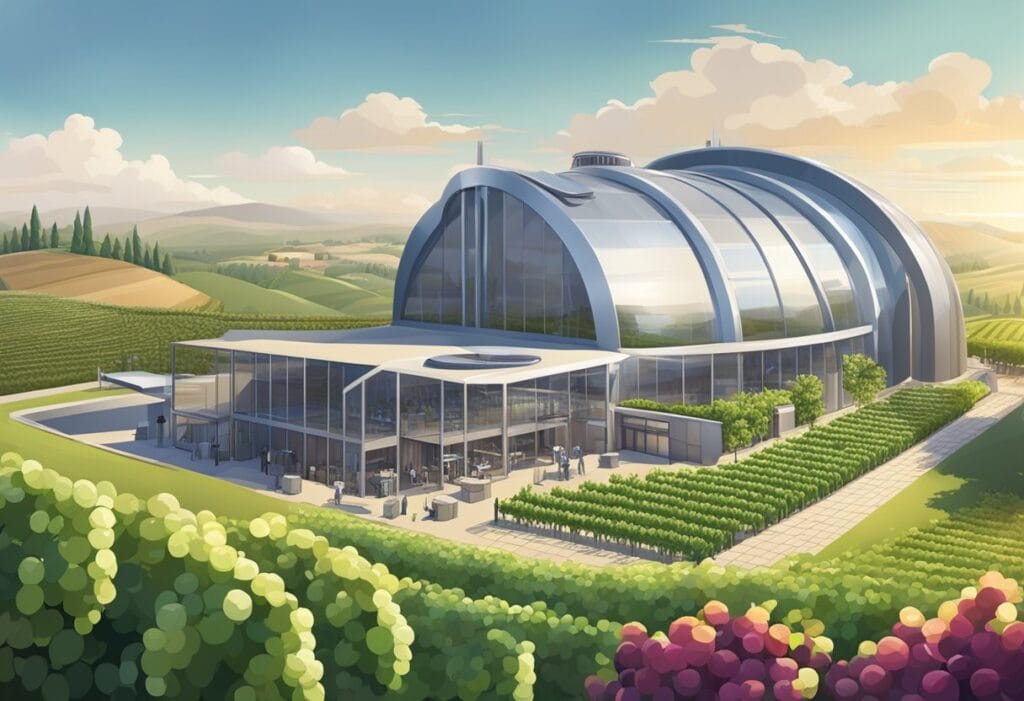
In the realm of entertainment, wine and technology intersect to enhance your experience with this ancient beverage. From learning about wine to selecting the perfect bottle, technology plays a pivotal role in how you interact with and enjoy wine.
Wine Education and Media
Wine Spectator and other media outlets have transformed wine education, making it accessible and engaging through various online platforms. You can now deepen your understanding of winemaking traditions, grape varieties, and tasting notes with interactive courses and videos. With resources like Ste. Michelle Wine Estates, you have the opportunity to explore extensive libraries of wine knowledge at your fingertips.
Wine Selection Aids and Applications
Navigating the vast world of wine is easier than ever with the aid of wine apps. Whether you’re using Winestein, a personal sommelier app, or other wine selection tools, these applications provide personalized recommendations based on your taste preferences and past selections. Such technology ensures you make informed choices, whether you’re hosting a dinner party or searching for the perfect wine pairing.
Social Media Influence on Wine Popularity
Social media has significantly impacted the popularity of wine within the entertainment area. Platforms like Instagram and Facebook allow wine enthusiasts and influencers to share their wine experiences, reviews, and recommendations. As a result, you can discover new wines and stay updated on trends within the wine community through the content that circulates on your social media feeds.
Implications for Future Winemaking
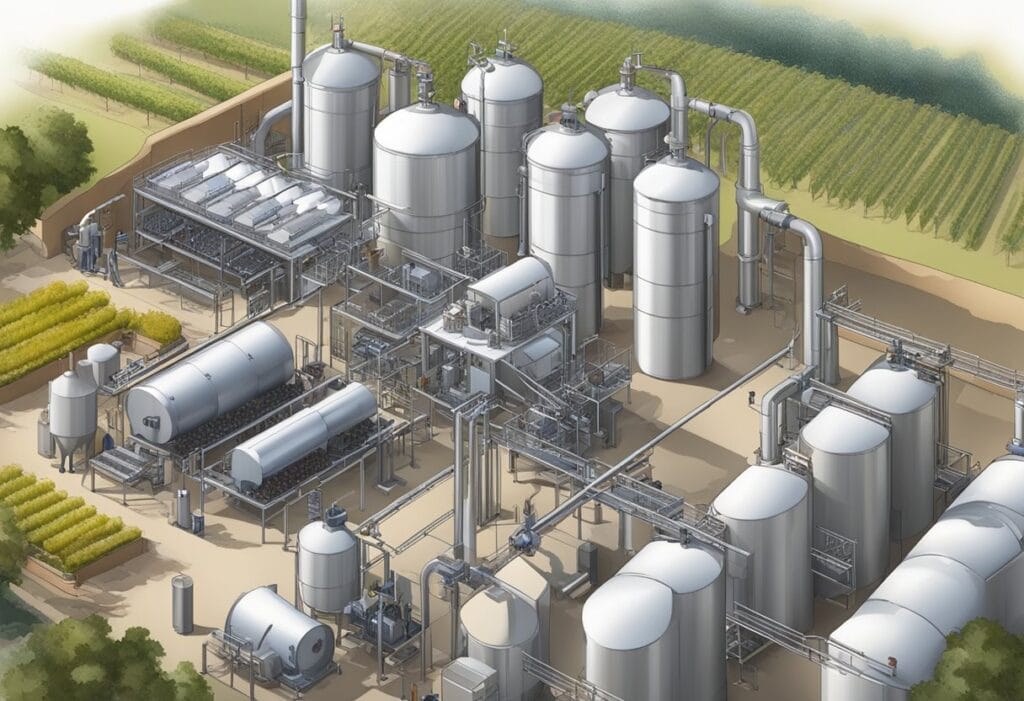
As you explore the evolving landscape of winemaking, consider the fusion of timeless techniques with the advancements of the fourth industrial revolution. This integration promises enhanced efficiency and sustainable practices in winemaking methodologies.
Next Steps in Wine Technology
Next-generation technologies are transforming vineyards into high-precision agricultural domains. Artificial intelligence plays a pivotal role in monitoring soil conditions and managing water resources optimally, leading to smarter viticulture decisions. Coupled with this, automated drones equipped with thermal cameras provide accurate vine health insights, enabling a more efficient resource allocation.
Challenges and Opportunities for Wineries
While technology offers numerous advantages, wineries face the challenge of integrating new systems without compromising the art of winemaking. Balancing innovation with tradition is critical. Wineries have the opportunity to increase productivity and quality, but must adapt to technological shifts while maintaining their unique brand essence.
Sustainability and Eco-friendly Practices
Sustainability is not just a buzzword; it’s a necessity. Ethical considerations and environmental impacts are driving the adoption of eco-friendly winemaking practices. From utilizing solar power to adopting water conservation technologies, wineries are pioneering a movement towards bio protection and resource preservation.
By adopting these innovative measures and philosophies, your winery can stand at the forefront of this exciting transformation, blending heritage with the technology of tomorrow.

